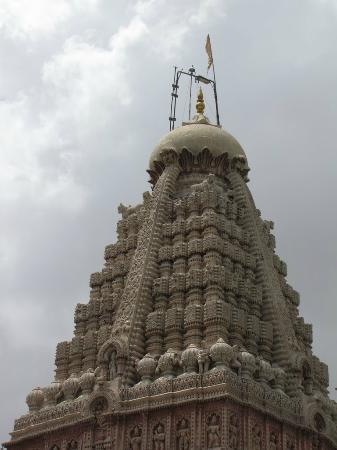Bibi Ka Maqbara
The Bibi ka Maqbara, the sole illustration of the Mughal architecture in the Deccan Plateau was built in the model of Taj Mahal. The creator of this tomb was the son of Aurangzeb, who built it to pay homage to his mother Begum Rabia Durani.
The
Ka Maqbara literally "Tomb of the Lady" is a maqbara located in
Aurangabad Maharashtra
India
It was commissioned by the sixth
Mughal Emperor
Aurangzeb
in the late 17th century in the memory
of his first wife,Dilras Banu Begum(posthumously known as
Rabia-ud-Daurani)It bears a striking resemblance to the
famous Taj Mahal the mausoleum of his mother Mumtaz Mahal.

Ellora
Ellora Caves throw light on the tolerance of the people of ancient India who were ready to accommodate other beliefs and faiths. Ellora Caves are spaced over 2 kilometers and there are 34 caves representing three religions namely Buddhism, Hinduism and Jainism. The monuments date between 600 A.D. and 1000 A.D. All the 34 temples and monasteries were dug adjacent to each other in the walls of a cliff. The first 12 caves are Buddhist Caves and they are the oldest. The next 17 caves are the Hindu Caves. The last 5 caves are Jain Caves. The architectural expertise and the efforts taken by the artisans in constructing buildings out of rocks have no words to admire enough.

-
Ajanta
Ajanta Caves top the list of favorites when one visits Aurangabad. Declared as World Heritage Site by UNESCO, Ajanta Caves have been visited by tourists from all parts of the world. The mural paintings in Ajanta Caves display unique style that cannot be seen in any part of the world. The paintings depict the events on the life of Buddha and there are illustrations on Buddhist deities. The stunning paintings reveal the skills and artistry of the artists and they effectively narrate the events without the need for words. A lot of researches were undertaken to learn about the mystery behind the life of paintings. The paintings have withstood the test of time and the colors are fresh and glowing.

-
Aurangabad Caves
The Aurangabad caves are 12 artificial rock-cut Buddhist shrines located on a hill running roughly east to west, nearly 2 km north from Bibi Ka Maqbara in Aurangabad, Maharashtra. The first reference of Aurangabad Caves is cited in the big Chaitya of Kanheri. The Aurangabad Caves were dug out of comparatively soft basalt rock during the 6th and 7th century. Caves are divided into three separate groups depending on their location. Sculptural carvings of Aurangabad Caves reached belong to highest achievements of Indian classical art and can be compared to the best paintings of Ajanta.
The cave temples of Aurangabad cut between the 6th and the 8th century are nine kilometers from Aurangabad, near Bibi-ka-Maqbara.Carved in the Sihaychal ranges, overlooking the sprawling campus of Dr Babasaheb Ambedkar Marathwada University, it is a protected monument under the Archaeological Survey of India.

-
Daultabad Fort
Daulatabad is what Daulatabad fort was called after it came into possession of Muhammad-bin-Tughluq. It carries the distinction of remaining undefeated in battle. It is a 14th-century fort city in Maharashtra, India, about 16 kilometers northwest of Aurangabad.
Daulatabad Fort magnificent 12th century fortress stands on a hill, Built by Raja Bhillamraj once known as 'Devgiri', Initially a Yadav stronghold, it passed through the hands of several dynasties in the Deccan. The ‘Daulatabad’ (city of fortune) name was give by Muhamad Tughlaq, Sultan of Delhi.
When Muhammad Tughlak ascended the Delhi throne, he was so taken by the fortress that he decided to move his court and capital there, renaming it Daulatabad, "the City of Fortune". He ordered the entire population of Delhi to move out en masse to the new capital.

-
Panchakki
Panchakki (water mill) takes its name from the mill which used to grind grain for the pilgrims. This monument located in Aurangabad, displays the scientific thought process put in medieval Indian architecture. The complex of Panchakki had been a place of external abode of the great Sufi Saints who gathered to India in 12th Cent A.D. The Panchakki, is a calm and peaceful place that visualizes the life that existed in the medieval period. Visitors having sensitive imagination may hear the beats of drum and the humming noise of the people moving around the complex. It is an engineering marvel of the medival period.

-
Grishneshwar Temple
Ghrishneshwar Temple belongs to 18th century. It is just half a kilometer from Ellora Caves. The marvelous architecture is awe-inspiring though you cannot hope to see the complete ancient architecture here owing to the damage caused by Aurangazeb. A peaceful place and it is frequented by tourists, as it is one of the twelve Siva temples(Jyotirlings).

-
Shirdi
108 kms from Aurangabad is the abode of one of Maharashtra's most revered saint -- Sai Baba of Shirdi. Popularly known as the 'Child of God', Sai Baba preached tolerance towards all religions and the message of universal brotherhood.
Every activity at Shirdi revolves around the vast temple complex dedicated to Sai Baba. Devotees start queuing up in the early hours of dawn to catch a glimpse and seek the blessings of the life-size statue of Sai Baba. Thursday is marked by special pujas and darshan of the Sai Baba statue. There are other places of interest that devotees can visit as well including Dwarkamani Mosque where the Baba meditated and slept on alternate nights. Near the mosque, in a corridor is the dhuni or eternal flame that burns day and night. Other places of importance are the Gurusthan, the Kandoba Temple, Shani Mandir, Narsimha Mandir, Changdev Maharaj Samadhi and the Sakori Ashram.
